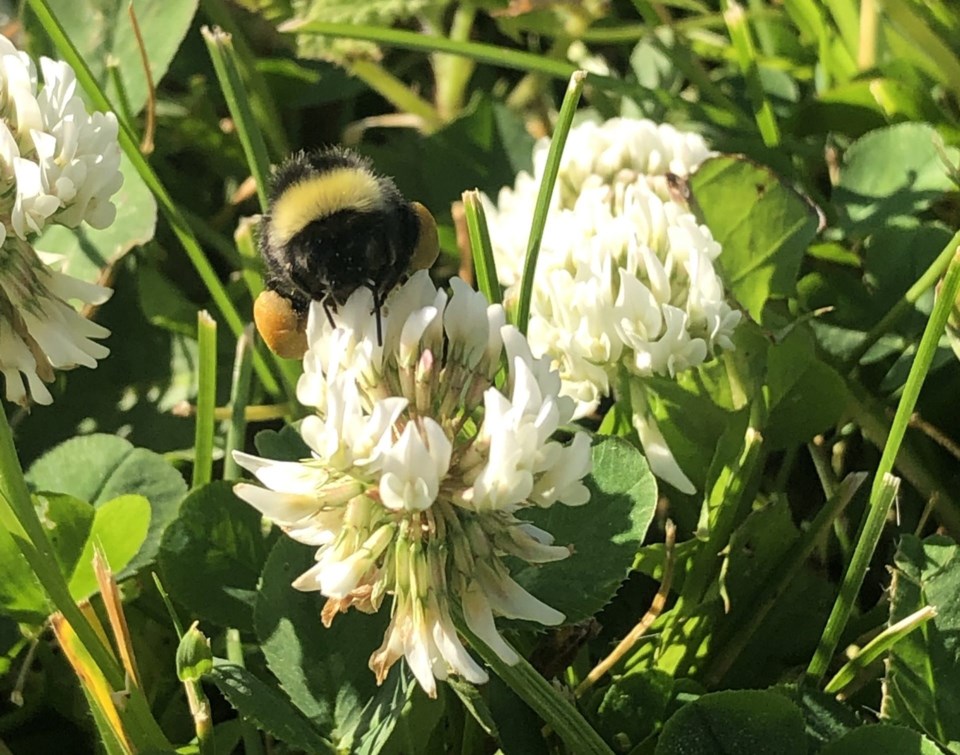Scott Hayes, Local Journalism Initiative Reporter | [email protected]
The bees could use all the help that they can get these days.
Due to decades of pervasive neonicotinoid-based pesticide applications, these little buzzing friends have declined in numbers for nearly 30 years.
Last year’s heatwave also caused favourable conditions for the development of the varroa mite. That parasite caused vast overwinter deaths, according to the recent colony loss report of the Canadian Association of Professional Apiculturists, putting the toll at nearly half of Canada's honeybee colonies.
That explains why the Nature Conservancy of Canada (NCC) teamed up with Wildlife Preservation Canada to offer a “bumble bees 101” presentation called Preserving the Buzz on July 20. The effort, part of NCC’s Bumble Bee Recovery program, had a hearty reception from some Hinton residents.
Lizz Leboeuf explained that she has been really getting into bees recently, an effort that largely revolves around her front yard.
“No Mow May is an easy ‘yes’ in our house as I thoroughly enjoy sitting on my front step watching and listening to the bees buzz around my bumper crop of dandelions,” she said, referring to the self-explanatory growing worldwide initiative that started in the United Kingdom.
No Mow May helps give wild pollinators such as butterflies and bees some extra time and the early-season green space so that they can carry more pollen to fertilize plants, trees, vegetable and flower gardens.
Helping them helps us, Leboeuf continued. Along with avoiding pesticide use, she does plant a wide array of flowers in her flowerbeds. The bees in turn went about their business and offered some entertainment to her and her pet as well.
“I did notice there was a solitary bee taking up residency in between my foundation and step. I was quite joyfully watching him come and go, his legs huge with pollen,” she said, adding that she installed some planters as “defence turrets” to keep her French bulldog Gus away from her newly-named flying friend.
“After having to shoo Gus away from ‘Kevin’ a few times, I decided I had to do something to protect him.”
At Charlotte MacFarlane’s house, she has been planting wildflowers in her gardens and a wild clover mix on her lawn, all in the name of making friends with the bees.
“I'm trying to get my clover to take over all of the grass,” she said. “My neighbours hate it but that’s my plan.”
She has seen at least three species of bees buzzing around her yard, thanks to her efforts. If she sees them out then she avoids tending her yard work just to give them some added freedom too.
Three species is excellent, especially considering that the yellow-banded bumble bee, the rusty-patched bumble bee and the western bumble bee were all once some of the most common bumble bee species within their ranges in Canada and all are considered to be in decline by the Committee on the Status of Endangered Wildlife in Canada.
Wildlife Preservation Canada in co-operation with the NCC, a land trust organization, both hope to turn that around. Sean Feagan, NCC’s media and communications co-ordinator in Alberta, said more attention is needed, especially because bees are relatively small in size.
“I think when a lot of people think about conservation, they think of charismatic megafauna: Grizzly bears, pronghorn out on the prairie, things like that,” he said.
“Conserving natural landscapes helps an array of organisms, and that includes small insects such as bees.”
He noted that native bumble bee species number in the dozens within Alberta alone.
“Even within that single genus, there is incredible diversity,” he said.
“I think illustrating that diversity, I think, can open a lot of eyes. People generally have an understanding or an acceptance that they are important from not just an ecological standpoint but also from a standpoint in terms of human crop production.”
Keeping that perspective, he added, helps to ensure that the public consider conservation efforts just as important for bees as they are for larger creatures.
MacFarlane said that her yard is filled with bugs, thanks in part to her efforts.
“I want people to get out of the culture of having pristine lawns. I've always been an animal lover and plant lover and nature lover. I've understood that our lawns are home to all of these bugs and how important bees are for our future as well.”
She said that she was considering attending the Preserving the Buzz program as a way of taking her bee love to the next level.
Leboeuf concurred with that, adding that she hopes to apply what she learns on her quest to photograph creatures for Big Backyard BioBlitz, the NCC’s nationwide nature event to observe and document fauna and flora where you live. It takes place from July 28 to Aug. 1. People can sign up via its website at .




